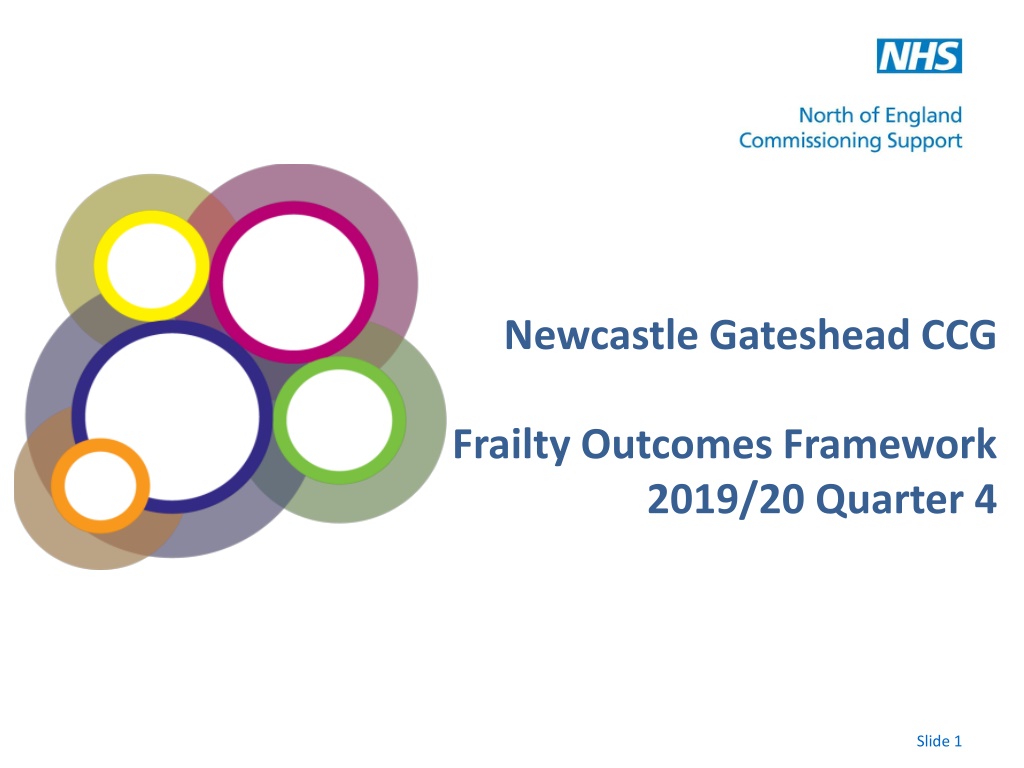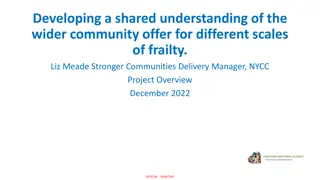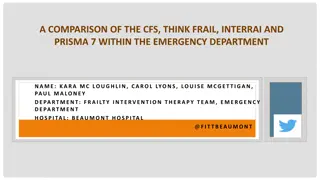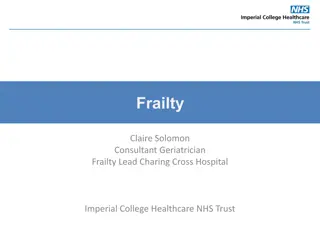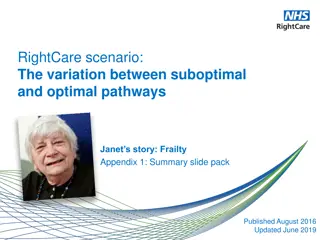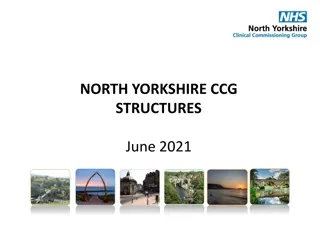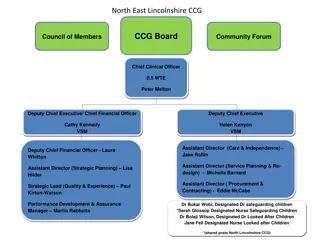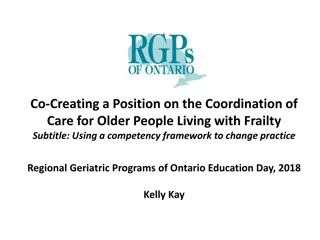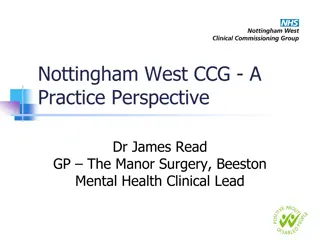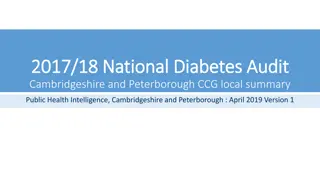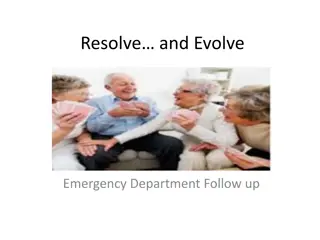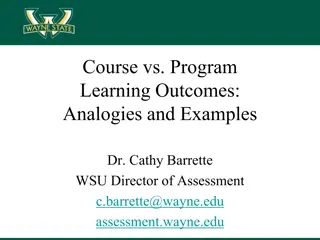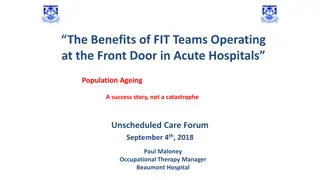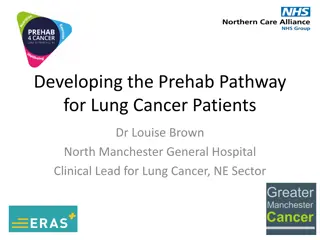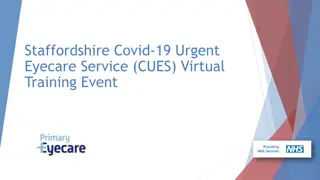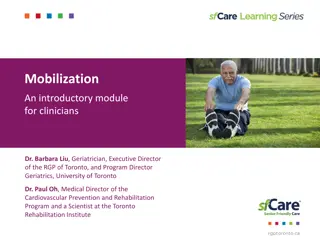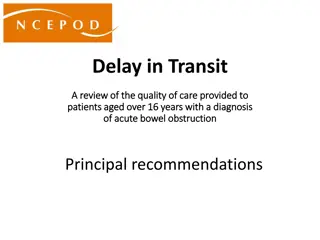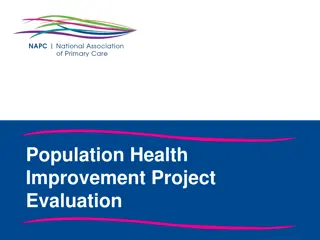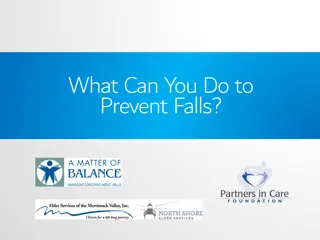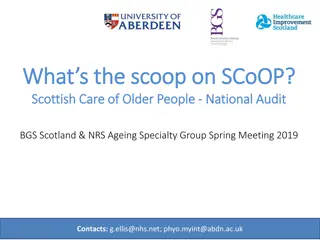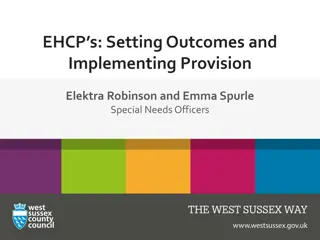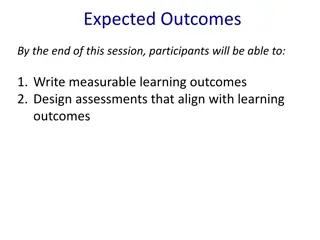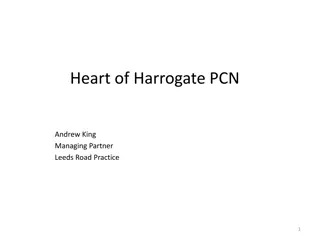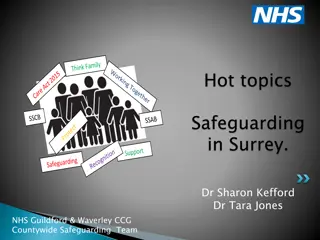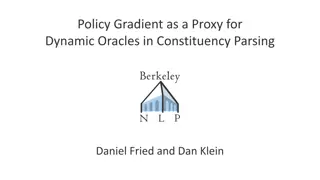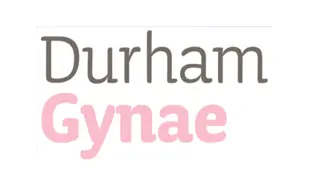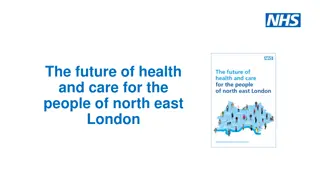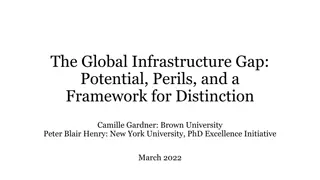Newcastle Gateshead CCG Frailty Outcomes Framework 2019/20
The Newcastle Gateshead CCG Frailty Outcomes Framework for Quarter 4 of 2019/20 provides insight into demographic information, frailty assessments, falls, and medication reviews for patients aged 65+. The data showcases proportions of patients in nursing homes, deprivation scores, frailty assessments, recorded statuses, falls, and medication reviews. Regional variations in assessment rates are highlighted, indicating areas of improvement needed for better healthcare outcomes.
Download Presentation

Please find below an Image/Link to download the presentation.
The content on the website is provided AS IS for your information and personal use only. It may not be sold, licensed, or shared on other websites without obtaining consent from the author. Download presentation by click this link. If you encounter any issues during the download, it is possible that the publisher has removed the file from their server.
E N D
Presentation Transcript
Newcastle Gateshead CCG Frailty Outcomes Framework 2019/20 Quarter 4 Slide 1
Demographic Information The Proportion of Patients Aged 65+ (Apr-20) The Proportion of Practice Population Who Live in a Nursing Home (Apr-20) 30% 0.7% 25% Proportion (%) Proportion (%) 0.6% 20% 0.5% 15% 0.4% 0.3% 10% 0.2% 5% 0.1% 13% 18% 19% 19% 19% 19% 20% 20% 20% 21% 23% 25% 26% 0.2% 0.2% 0.2% 0.3% 0.3% 0.3% 0.4% 0.4% 0.4% 0.4% 0.6% 0.6% 0.6% 0% 0.0% CNE Region CNE Region In order to understand the context of organisational achievement for each metric, key information relating to the populations has been presented. The GP Practice Deprivation Score Estimate (2019) 40 35 30 IMD Score 25 20 15 10 The proportion of patients aged 65 years and over is taken from the quarterly published practice populations to HSCIC. 5 21.7 21.9 22.1 22.3 25.7 28.2 28.8 29.8 30.6 31.4 31.5 35.2 0 The GP practice deprivation score estimate (2019) is based on the registered population of each GP practice. CNE Region England Partners in improving local health
Frailty Assessments & Recorded Status Recorded Frailty Status of Patients Aged 65+ (Mar 2020) The Proportion of Patients Aged 65+ Who Have Had a Frailty Assessment (Mar 2020) 100% 90% 40% Proportion (%) 80% 35% Proportion(%) 70% 96%93% 92% 91% 91% 90% 89% 86%82%71% 70%66% 64% 30% 60% 25% 50% 20% 40% 15% 30% 10% 20% 8% 12%24%23% 29% 30% 5% 7% 8% 9% 9% 10% 11% 14% 18% 29% 30% 34% 36% 10% 7% 6% 8% 5% 0% 0% Severe Moderate None/Mild No Assessment CNE Region Data regarding frailty assessments has been taken from the nationally published GMS PMS Core Contract Data Collection. The proportion of patients aged 65 years and over who have had a frailty assessment recorded varies substantially by CCG. North Cumbria and Gateshead have a much higher rate of assessment than their peers. Partners in improving local health
Frailty Assessments Falls and Review Proportion of Patients Aged 65+ with Moderate or Severe Frailty, Who Have Had a Fall in the Last 12 Months (Mar 2020) Proportion of patients aged 65+ years with severe frailty, who have received an annual medication review, by CCG, to the end of Mar 2020 40% 100% 35% Proportion (%) Proportion (%) 80% 30% 25% 60% 20% 40% 15% 10% 20% 5% 6% 8% 8% 11% 11% 13% 16% 17% 18% 19% 20% 34% 42% 48% 49% 52% 54% 55% 60% 63% 65% 65% 69% 70% 79% 5% 0% 0% CNE Region CNE Region Across CNE, the proportion of patients aged 65+ years with moderate or severe frailty who have had a fall recorded in primary care ranges from 5% to 34%. The proportion of patients aged 65+ years with severe frailty who have received a medication review ranges from 42% to 79%, as shown in the chart above. An increase in frailty assessments, however, would present a much clearer picture for both falls and medication reviews. Partners in improving local health
Polypharmacy Percentage of Patients Aged 65+ Who Have Been Prescribed 10 or More Unique Medicines (Mar-20) 14% 12% 10% Proportion (%) 8% 6% 4% 2% 6% 8% 8% 8% 9% 10% 10% 10% 10% 10% 11% 11% 13% 0% Mar-20 CNE Region England Mar-19 The percentage of over 65 year olds receiving 10 or more unique medicines in the region remains higher than that for England as a whole with considerable variation reported between CCGs. In Newcastle, 13% of the population receive 10 or more medicines while this figure is 6% in HRW. Significant variation at practice level is also apparent. Partners in improving local health
Flu Proportion of Patients Aged 65+ Years Who Have Received the Seasonal Influenza Vaccine (Feb 2020) 100 90 80 Proportion (%) 70 60 50 40 30 20 10 71.6 71.8 72.4 73.0 73.7 73.9 74.2 74.6 74.6 74.8 74.9 75.1 76.5 0 CNE Region The cumulative influenza vaccine uptake in those aged 65+ years for CNE is 73.9%. There is little variance across the CCGs in CNE. The ambition for vaccine coverage in 2019 to 2020 was to reach or exceed 75% uptake for people aged 65+ years (as recommended by the World Health Organization (WHO)). Partners in improving local health
Dementia The Rate of Those Aged 65+ With a Recorded Diagnosis of Demetia in their GP Record Expressed per Person Estimated to have Dementia (Mar 2020) The Proportion of Those Aged 65+ With a Severe or Moderate Frailty, Who Have a Diagnosis of Demetia in their GP Record (Mar-2020) 100% 35% 30% Proportion (%) Proportion (%) 80% 25% 60% 20% 15% 40% 10% 20% 56% 65% 67% 69% 69% 70% 72% 75% 75% 77% 77% 77% 83% 12% 13% 14% 17% 17% 18% 18% 20% 21% 23% 24% 30% 5% 0% 0% CNE Region England CNE Region The estimated diagnosis rate of dementia in those aged 65+ years for the latest 12 months varies across the CNE region from 56% in HRW to 83% in HAST. The CNE average is 71% which is higher than the England rate of 67%. The proportion of those living with moderate or severe frailty who have dementia also varies across the region. North Cumbria has the lowest rate in the region with 12% of patients having a dementia code on their GP record, North Durham has the highest proportion at 30%. Note that the frailty data used here is from GP records as opposed to GMS PMS Core Contract Data Collection. Partners in improving local health
Depression The Proportion of Those Aged 65+ With Severe or Moderate Frailty, Who Have a Diagnosis of Depression in their GP Record (Mar-2020) 20% 18% 16% Proportion (%) 14% 12% 10% 8% 6% 4% 2% 14% 14% 15% 15% 15% 16% 16% 16% 17% 17% 17% 18% 0% CNE Region The risk of mental health conditions (such as depression and anxiety) and cognitive decline has frequently been reported to increase as the number of chronic conditions increases (and with age). The proportion of those living with moderate or severe frailty who have depression varies across the region. North Cumbria has the highest rate in the region with 18% of patients having a dementia code on their GP record. Sunderland has the lowest proportion at 14%. Note that the frailty data used here is from GP records as opposed to GMS PMS Core Contract Data Collection. Partners in improving local health
Service Users with Control over their Daily Life ASCOF 1B: The proportion of people who use services who have control over their daily life 2018/19 (Age 65+) ASCOF 1B: The proportion of people who use services who have control over their daily life 2018/19 (Age 65+) 90 90 80 Proportion (%) 80 70 60 70 50 Proportion (%) 40 60 30 20 50 62.7 68.4 71.9 72.5 74.1 75 76.4 76.6 79.2 80.6 81.7 82.7 84.4 85.2 10 0 40 30 20 10 0 % 65+ CNE Region England LA North East England The data presented shows the North East region to have a higher proportion (76.0%) than the England average (74.4%) for this indicator. There is some variation between regional local authorities with Hartlepool achieving the highest outcome (85.2%) compared to Darlington reporting the lowest outcome (62.7%). Cumbria and North Yorkshire have also been included for the scope of this project, but will not be included in the North East regional figure. Partners in improving local health
Service Users with Contact ASCOF 1I(1): The proportion of people who use services who reported that they had as much social contact as they would like 2018/19 (Age 65+) ASCOF 1I(1): The proportion of people who use services who reported that they had as much social contact as they would like 2018/19 (Age 65+) 60 70 Proportion (%) 50 60 40 30 Proportion (%) 50 20 40 10 42.5 42.9 46.1 46.7 47 48 48.2 48.7 48.8 48.9 50.7 53.2 53.3 57 0 30 20 10 0 % 65+ CNE Region England LA North East England The data presented shows the North East region to have a higher proportion (48.4%) than the England average (43.5%) for this indicator. There is some variation between regional local authorities with Hartlepool achieving the highest outcome (57.0%) compared to South Tyneside reporting the lowest outcome (42.5%). All local authorities with the exception of South Tyneside and North Tyneside in the region have reported above the England average for this measure. Cumbria and North Yorkshire have also been included for the scope of this project, but will not be included in the North East regional figure. Partners in improving local health
Carer Reported Quality of Life ASCOF 1D: Carer-reported quality of life score 2018/19 (Age 65+) ASCOF 1D: Carer-reported quality of life score 2018/19 (Age 65+) 12 10 Score (Out of 12) 10 8 8 6 Proportion (%) 4 6 2 7.7 7.8 8 8 8 8 8.1 8.1 8.1 8.2 8.2 8.3 8.5 8.6 0 4 2 0 CNE Region England LA North East England The data presented shows the North East region to have a higher score (8.1) than the England average (7.8) for this indicator. There is some variation between regional local authorities with Northumberland achieving the highest outcome (8.6) compared to North Tyneside reporting the lowest outcome (7.7). Cumbria and North Yorkshire have also been included for the scope of this project, but will not be included in the North East regional figure. Partners in improving local health
A&E Attendances and Admissions A&E Attendance Rate (Per 1,000 Population) for Patients Aged 65+ (2019/20) A&E Attendance to Emergency Admission Conversion Rate 65+ (2019/20) 700 60% Proportion (%) Per 1,000 65+ Population 600 50% 500 40% 400 30% 300 20% 200 10% 100 20% 22% 29% 29% 30% 39% 41% 42% 46% 48% 53% 349.2 363.9 427.7 439.2 447.3 494.9 500.1 516.2 523.1 551.9 607.4 608.3 0 0% CNE Region CNE Region The data presented here relates only to attendances at A&E Type 1 departments (consultant-led, 24 hour service) and Type 3 departments (Other A&E / minor injury departments, doctor- or nurse-led). For 2019/20 YTD there is a wide range in A&E attendance rates across the CNE region, from 349.2 per 1,000 population in North Durham to 608.3 in Gateshead. The CNE region A&E attendance rate for this period is 472.4 per 1,000 population. The A&E attendance to emergency admission conversion rate for 2019/20 varies substantially across the CNE region from 20% in North Tyneside CCG to 53% in Newcastle. The CNE region conversion rate for this period is 35%. It is possible that variation can be due to differences in patient pathways and data recording across the hospital Trusts and the availability of services such as ambulatory care within the inpatient setting. Partners in improving local health
Emergency Admissions & Readmissions Emergency Admission Rate (Per 1,000 Population) for Patients Aged 65+ (2019/20) Emergency Admission Rate (Per 1,000 Population) Due to Falls for Patients Aged 65+ (2019/20) 600 50 Per 1,000 65+ Population Per 1,000 65+ Population 500 40 400 30 300 20 200 10 100 20.8 21.2 24.1 24.7 25.0 25.6 31.3 32.3 33.1 35.9 38.5 43.7 204.3 231.1 232.0 239.7 259.5 259.6 263.8 270.5 298.5 315.9 354.2 477.9 0 0 CNE CNE Emergency readmissions within 30 days of discharge from hospital 65+ (2019/20) The emergency admission rate for over 65s varies across the CNE region from 204 per 1,000 population in North Cumbria, to 478 in Newcastle. 250 Per 1,000 65+ Population 200 150 100 50 145.0 152.4 164.3 167.8 169.4 173.4 173.5 181.7 186.9 188.5 195.9 204.9 0 North Cumbria also has the lowest rate of falls related admissions. CNE Partners in improving local health
Stranded Patients The Proportion of Stranded Patients in Hospital : Length of Stay 7+ Days (Snapshot as at 31/03/2020) 60% 50% 22% Proportion (%) 40% 16% 19% 21% 20% 14% 14% 14% 30% 12% 9% 4% 13% 9% 8% 8% 9% 20% 22% 21% 10% 20% 19% 19% 18% 17% 17% 0% North Tees And Hartlepool County Durham And Darlington Gateshead Health South Tees Hospitals Northumbria Healthcare NuTH City South Tyneside Hospitals Sunderland 7-13 Days 14-20 Days 21+ Days The data presented shows the Cumbria and North East region to have varied proportions of Stranded Patients with North Cumbria reporting 64% and North Tees and Hartlepool reporting 40% for patients with a length of stay of 7 or more days. Partners in improving local health
Reablement/Rehabilitation Services ASCOF 2B(1): The proportion of older people (aged 65 and over) who were still at home 91 days after discharge from hospital into reablement/rehabilitation services 2018/19 ASCOF 2B(1): The proportion of older people (aged 65 and over) who were still at home 91 days after discharge from hospital into reablement/rehabilitation services 2018/19 100 120 Proportion (%) 80 100 60 Proportion (%) 40 80 20 65.5 68.3 74.7 78.7 79.7 80.6 83.6 84 85.4 85.6 85.8 86.5 89.7 92 0 60 40 20 0 CNE Region England LA North East England The data presented shows the North East region to have a slightly lower proportion (81.4%) than the England average (82.4%) for this indicator. There is some variation between regional local authorities with North Tyneside achieving the highest outcome (92.0%) compared to Middlesbrough reporting the lowest outcome (65.5%). Cumbria and North Yorkshire have also been included for the scope of this project, but will not be included in the North East regional figure. Partners in improving local health
Residential and Nursing Care Homes ASCOF 2A(2): Long-term support needs of older adults (aged 65 and over) met by admission to residential and nursing care homes, per 100,000 population 2018/19 ASCOF 2A(2): Long-term support needs of older adults (aged 65 and over) met by admission to residential and nursing care homes, per 100,000 population 2018/19 1400 1600 1200 Rate per 100,000 1400 1000 Rate per 100,000 800 1200 600 1000 400 200 574.7 592.6 616.1 632.4 712.8 717.9 723.9 740.9 776.7 886.5 920 927.71102.8 1172.8 800 0 600 400 200 0 CNE Region England LA North East England The data presented shows the North East region to have a higher rate per 100,000 population (792.7) than the England average (580.0) for this indicator. There is some variation between regional local authorities with Middlesbrough reporting the highest proportion of permanent admissions (1172.8) compared to Stockton-on-Tees (574.7). Cumbria and North Yorkshire have also been included for the scope of this project, but will not be included in the North East regional figure. Partners in improving local health
Deaths in Usual Place of Residence Proportion of deaths in usual place of residence (Rolling annual 2018/19 Q4 - 2019/20 Q3) Proportion of deaths by place of occurrence (Rolling annual 2018/19 Q4 - 2019/20 Q3) 60.0% 100% 8% 18%13%24% 21%22%24% 22% 24% 25% 26% 31% 32% Proportion (%) Proportion (%) 50.0% 80% 5% 7% 5% 6% 40.0% 60% 53% 30.0% 49% 47% 45% 43% 49% 44% 44% 40% 41%38% 40% 40% 20.0% 20% 10.0% 25%31%21% 25% 26% 24% 27% 26% 27% 27% 25% 24% 43% 45% 45% 47% 48% 48% 50% 51% 52% 54% 56% 57% 0.0% 0% Home Hospital Hospice Care Home Elsewhere The data presented in the top left chart shows the proportion of deaths in the usual place of residence and relates to ALL deaths, not limited to those aged 65+ years. The CNE region has a higher rate of deaths in the usual place of residence than England overall however there is variation across the CCGs from 43.1% in Sunderland CCG to 56.7% in North Tyneside CCG. The top right chart shows all deaths for each CNE CCG in the period by place of occurrence and shows that 25.6% of deaths in the period occurred at home, which is slightly higher than the England rate of 24.3%. Partners in improving local health
